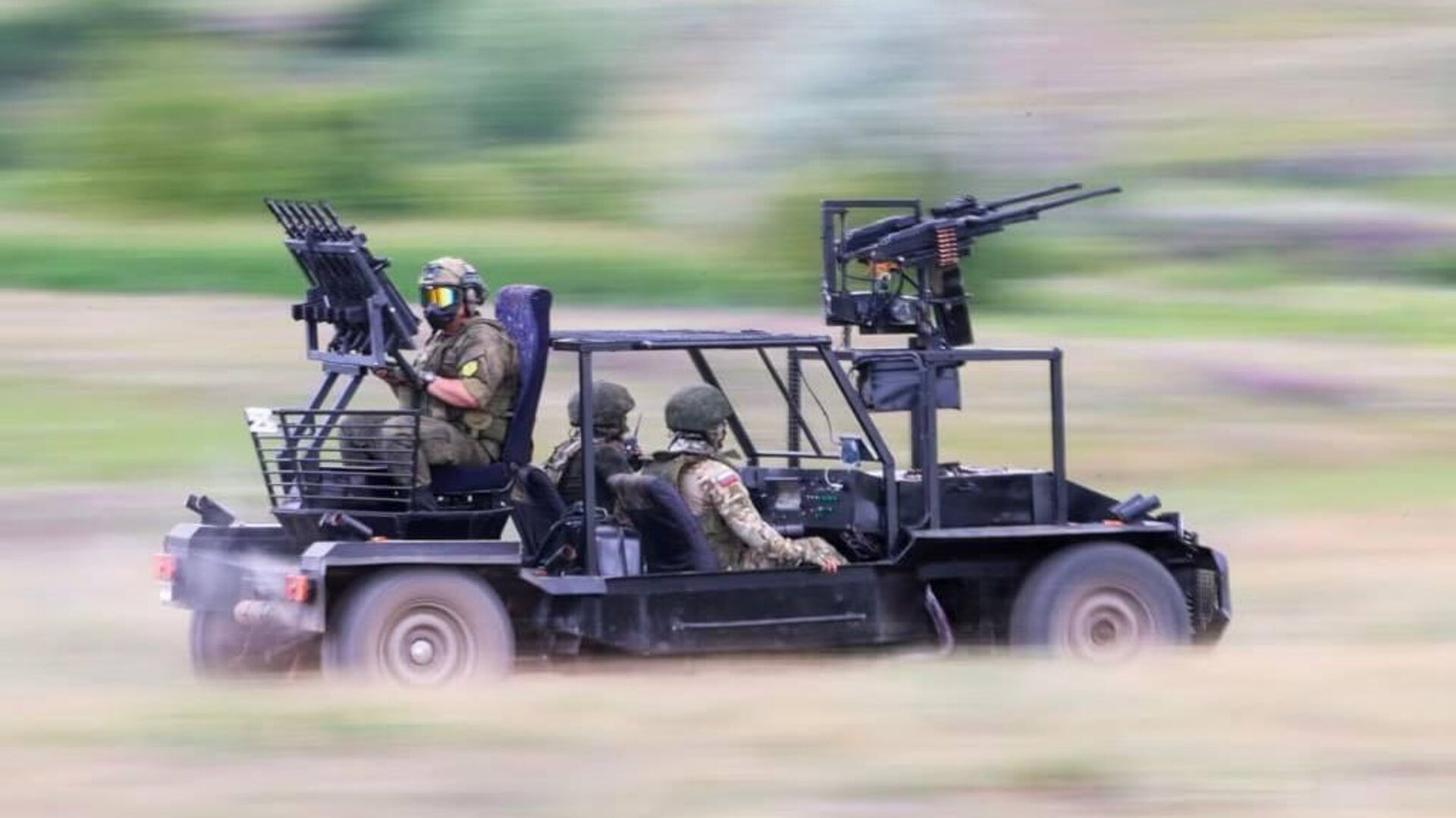https://sputniknews.in/20240828/lessons-from-ukraine-india-needs-to-enhance-anti-drone-tech-8073219.html
Lessons From Ukraine: India Needs to Enhance Anti-Drone Tech
Lessons From Ukraine: India Needs to Enhance Anti-Drone Tech
Sputnik India
High-Power Microwave (HPM) systems can disrupt electronic surveillance grids by emitting high-energy beams from distances at up to 5 kilometres, according to... 28.08.2024, Sputnik India
2024-08-28T21:06+0530
2024-08-28T21:06+0530
2024-08-28T21:06+0530
defenсe news
science & tech
india
ukraine
russia
people's liberation army (pla)
lancet drones
nuclear-capable underwater drones
kamikaze drones
kamikaze drone
https://cdn1.img.sputniknews.in/img/07e8/08/1c/8077644_0:11:1023:586_1920x0_80_0_0_446a900b4bba2b26ba9829f6868c997c.jpg
The Indian Army is upgrading its anti-drone capabilities by seeking advanced HPM systems to counter the growing threat from Unmanned Aerial Systems (UAS), reports India Today.The Indian Army currently relies on Russian systems like Karshuka, Leer-3, Repellent and Pole 21, but is seeking a more integrated solution that enhances command and control, air defence and reporting capabilities.“Indian Army’s advancement in High-Power Microwave systems represents a major breakthrough in directed-energy weapons that can disrupt or destroy electronic components,” Retired Brigadier Arun Sahgal, Executive Director of the Forum for Strategic Initiative, told Sputnik India.Sahgal said the Indian Army's advances in HPM technology were a major breakthrough, although deployment quantities and capabilities have not been fully disclosed.According to the brigadier, the key challenges include developing HPM technology for high-altitude environments where power sources are limited and degradation occurs quickly due to weather conditions.“HPM systems offer a strategic advantage over kinetic 'hard kill' methods by providing a more effective electronic 'soft kill', which is harder to evade and can disrupt communication links and radar systems,” Saghal explained.While evading a high-energy source is exceptionally difficult, the expert also noted that Electromagnetic Pulse (EMP) weapons can similarly disrupt communication links and sensors.In this light, the Ukrainian attacks with Turkish Bayraktar drones underscore the global vulnerability to drone warfare, highlighting the urgent need for advanced anti-drone capabilities like HPM systems, Commodore (Ret.) RS Vasan, Director General at Chennai Centre for China Studies, told Sputnik India.He highlighted that the first step in assessing anti-drone capabilities is by learning from the Ukraine conflict and Yemeni attacks on oil tankers.Current anti-drone systems are primarily designed for infrequent attacks and often struggle to handle large-scale drone swarms, which can overwhelm them, he added.Since traditional countermeasures may be inadequate, according to Vasan, “making the integration of advanced technologies like HPM systems crucial to address evolving drone threats.”The commodore stressed that effective anti-drone strategies require sophisticated intelligence and detection to locate and track drone launch sites using satellites and monitoring tech.AI-equipped drones are increasingly sophisticated and harder to counter, making preparation for advance drone warfare essential, Vasan said. Emerging threats include containerised drones that can be launched from merchant ships or other inconspicuous platforms, creating major challenges for naval and maritime defence, the commodore explained.Vasan further noted that drone attacks in conflicts “highlight the evolving nature of drone warfare, making lessons from these incidents essential for crafting effective countermeasures.”Rapid advances in drone technology necessitate ongoing upgrades and innovation in defence systems — and the Indian military must stay ahead of emerging threats by continuously evaluating and enhancing its anti-drone capabilities, he concluded.
https://sputniknews.in/20240808/indian-army-inducts-tiny-kamikaze-drones-to-target-terrorist-hideouts-in-kashmir-7983896.html
india
ukraine
russia
indian ocean
Sputnik India
feedback.hindi@sputniknews.com
+74956456601
MIA „Rossiya Segodnya“
2024
Swapna Nair
https://cdn1.img.sputniknews.in/img/07e7/09/12/4320104_0:0:681:681_100x100_80_0_0_ca8a7d4d582609272840ffdd1cde7278.jpg
Swapna Nair
https://cdn1.img.sputniknews.in/img/07e7/09/12/4320104_0:0:681:681_100x100_80_0_0_ca8a7d4d582609272840ffdd1cde7278.jpg
News
en_IN
Sputnik India
feedback.hindi@sputniknews.com
+74956456601
MIA „Rossiya Segodnya“
Sputnik India
feedback.hindi@sputniknews.com
+74956456601
MIA „Rossiya Segodnya“
Swapna Nair
https://cdn1.img.sputniknews.in/img/07e7/09/12/4320104_0:0:681:681_100x100_80_0_0_ca8a7d4d582609272840ffdd1cde7278.jpg
indian army, high-power microwave (hpm) systems, unmanned aerial systems (uas), indian army, russian systems, karshuka, leer-3, repellent, pole 21, integrated solution, command and control, air defence, reporting capabilities, indian army, high-power microwave (hpm) systems, directed-energy weapons, electronic components, brigadier (retd) arun sahgal, executive director of the forum for strategic initiative, hpm technology, quantities and capabilities, pla sensors, high-energy beams, operations, hpm technology, high-altitude environments, limited and degradation, hpm systems, communication links and radar systems, high-energy source, emp weapons, electromagnetic pulse weapons, kinetic weapons, electronic degradation, communications and radar system, ukrainian attacks, turkish bayraktar drones, drone warfare, anti-drone capabilities, high-power microwave (hpm) systems,commodore rs vasan (retd.), chennai centre for china studies, ukraine conflict, houthi attacks, oil tankers, russian models, high-power microwave (hpm) systems, anti-drone strategies, ai-driven drone warfare, russian ship moskva, drone technology, defence systems, indian military
indian army, high-power microwave (hpm) systems, unmanned aerial systems (uas), indian army, russian systems, karshuka, leer-3, repellent, pole 21, integrated solution, command and control, air defence, reporting capabilities, indian army, high-power microwave (hpm) systems, directed-energy weapons, electronic components, brigadier (retd) arun sahgal, executive director of the forum for strategic initiative, hpm technology, quantities and capabilities, pla sensors, high-energy beams, operations, hpm technology, high-altitude environments, limited and degradation, hpm systems, communication links and radar systems, high-energy source, emp weapons, electromagnetic pulse weapons, kinetic weapons, electronic degradation, communications and radar system, ukrainian attacks, turkish bayraktar drones, drone warfare, anti-drone capabilities, high-power microwave (hpm) systems,commodore rs vasan (retd.), chennai centre for china studies, ukraine conflict, houthi attacks, oil tankers, russian models, high-power microwave (hpm) systems, anti-drone strategies, ai-driven drone warfare, russian ship moskva, drone technology, defence systems, indian military
Lessons From Ukraine: India Needs to Enhance Anti-Drone Tech
High-Power Microwave (HPM) systems can disrupt electronic surveillance grids by emitting high-energy beams from distances at up to 5 kilometres, according to experts.
The Indian Army is upgrading its anti-drone capabilities by seeking advanced HPM systems to counter the growing threat from Unmanned Aerial Systems (UAS), reports India Today.
The Indian Army currently relies on Russian systems like Karshuka, Leer-3, Repellent and Pole 21, but is seeking a more integrated solution that enhances command and control, air defence and reporting capabilities.
“Indian Army’s advancement in High-Power Microwave systems represents a major breakthrough in directed-energy weapons that can disrupt or destroy electronic components,” Retired Brigadier Arun Sahgal, Executive Director of the Forum for Strategic Initiative, told Sputnik India.
Sahgal said the Indian Army's advances in HPM technology were a major breakthrough, although deployment quantities and capabilities have not been fully disclosed.
“HPM systems can target electronic surveillance grids by emitting high-energy beams to disrupt their operations from a range of up to 5 kilometers,” he said.
According to the brigadier, the key challenges include developing HPM technology for high-altitude environments where power sources are limited and degradation occurs quickly due to weather conditions.
“HPM systems offer a strategic advantage over kinetic 'hard kill' methods by providing a more effective electronic 'soft kill', which is harder to evade and can
disrupt communication links and radar systems,” Saghal explained.
While evading a high-energy source is exceptionally difficult, the expert also noted that Electromagnetic Pulse (EMP) weapons can similarly disrupt communication links and sensors.
Unlike kinetic weapons, which can be evaded through tactics, electronic degradation offers a more reliable method for targeting and disabling communications and radar systems, Sahgal explained.
In this light, the Ukrainian attacks with Turkish Bayraktar drones underscore the global vulnerability to drone warfare, highlighting the urgent need for advanced anti-drone capabilities like HPM systems, Commodore (Ret.) RS Vasan, Director General at Chennai Centre for China Studies, told Sputnik India.
He highlighted that the first step in assessing anti-drone capabilities is by learning from the Ukraine conflict and Yemeni attacks on oil tankers.
Current anti-drone systems are primarily designed for infrequent attacks and often struggle to handle
large-scale drone swarms, which can overwhelm them, he added.
Since traditional countermeasures may be inadequate, according to Vasan, “making the integration of advanced technologies like HPM systems crucial to address evolving drone threats.”
The commodore stressed that effective anti-drone strategies require sophisticated intelligence and detection to
locate and track drone launch sites using satellites and monitoring tech.
“While hard kill options, e.g., missiles, are important, soft kill technologies like jamming and spoofing are crucial for disrupting drone operations without physical destruction,” he noted.
AI-equipped drones are increasingly sophisticated and harder to counter, making preparation for advance
drone warfare essential, Vasan said. Emerging threats include containerised drones that can be launched from merchant ships or other inconspicuous platforms, creating major challenges for naval and maritime defence, the commodore explained.
Vasan further noted that
drone attacks in conflicts “highlight the evolving nature of drone warfare, making lessons from these incidents essential for crafting effective countermeasures.”
Rapid advances in drone technology necessitate ongoing upgrades and innovation in defence systems — and the Indian military must stay ahead of emerging threats by continuously evaluating and enhancing its
anti-drone capabilities, he concluded.



